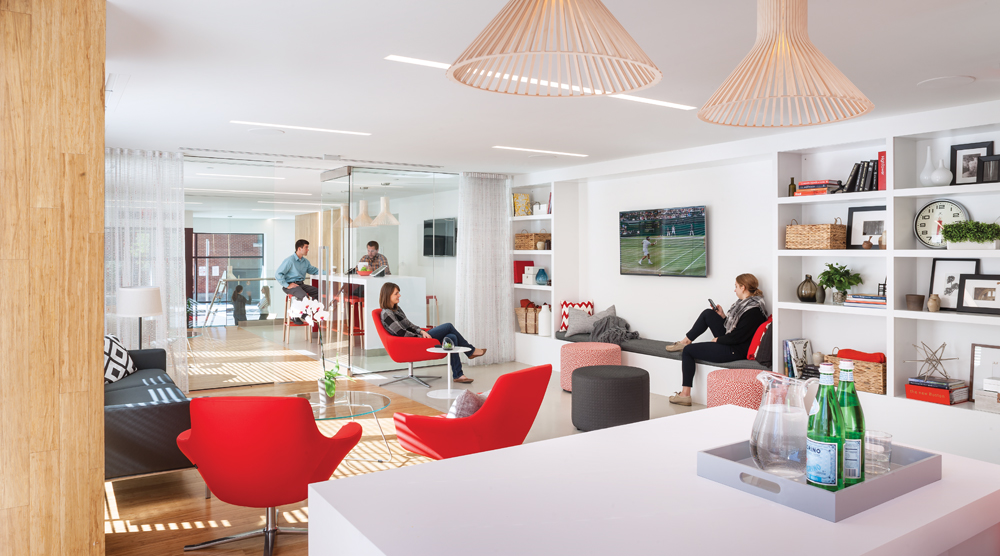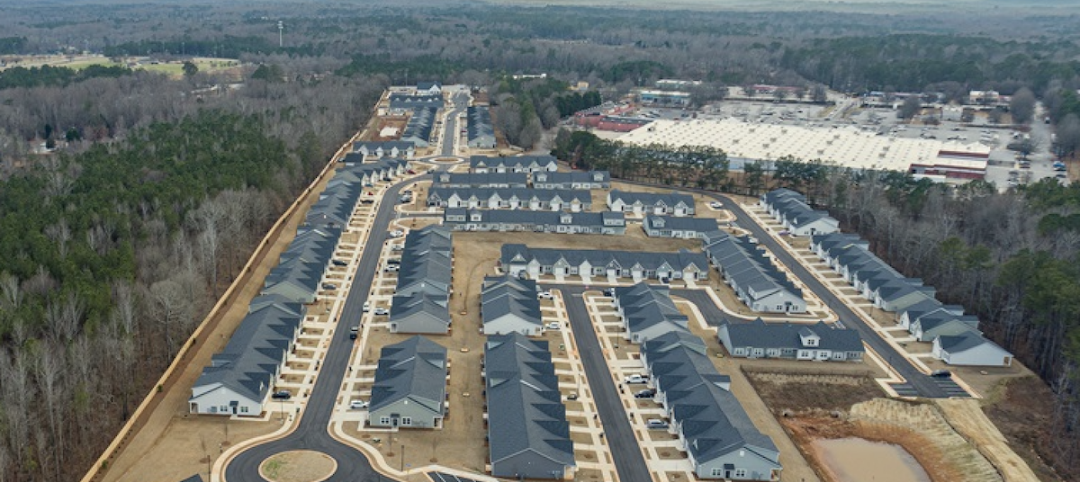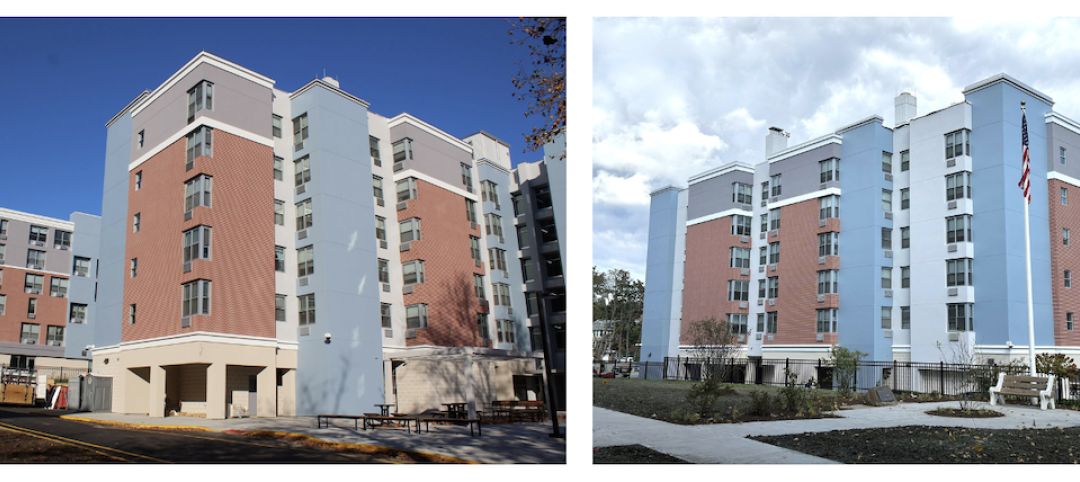In just about any metro area in the U.S., investors, developers, and builders are scrambling to keep pace with the surging demand for multifamily housing, especially rental apartments.
An estimated 351,000 multifamily units were started in 2014, up nearly 14% over 2013 and more than double the 6.6% growth rate for total housing starts last year, according to the National Association of Home Builders. In Nashville, multifamily completions jumped about 70%, according to commercial real estate brokerage Marcus & Millichap. Completions in Seattle were at their highest level since 2000. Dallas’s 19,000 completions led the nation, with Austin, Texas, and New York City, each with 14,000, hot on Big D’s heels. Phoenix’s 4,900 units might finally make a dent in a vacancy rate that in 2014 was as low as it had been in seven years.
5 TRENDS TO WATCH
1. Urban lifestyle
2. Affordable luxury
3. Amenities, amenities, amenities
4. Tenant control of technology
5. Green leases
“Condominium demand in Florida, which was virtually nonexistent from 2009 to 2012, is picking up, and inventories have been largely absorbed,” says Ted Cava, who overseas Gilbane’s development and construction activities in the Southeast.
As of mid-September, multifamily comprised 3.5% of outstanding bank loans, its highest share since 1992, according to American Banker magazine. About 90% of recent multifamily construction has been rental apartments. “As the labor market continues to recover, demand for rental properties will continue to run strong,” Freddie Mac predicted in its September U.S. Economic and Housing Market Outlook.
Capital is rushing into this sector in search of rich returns on investment. Through the first 11 months of 2014, Atlanta-based Carroll Organization purchased a dozen multifamily properties valued at more than $500 million. Michael Massie, Executive Vice President of The Picerne Group, a private REIT, says valuations “are taking off” in Southern California, “and that gives us confidence to invest in those markets.” Between March and September, Picerne broke ground on three mid-rise communities with a total of 676 apartments, including the first new multifamily project to be approved in Cerritos, Calif., in four decades.
Tom Brink, AIA, LEED AP, a Vice President with RTKL, points out that developers are demanding much higher densities from apartment buildings. “Apartments as skyscrapers [are] proving to be serious architecture,” says Brink. He also says there has been a surge in mid-rise districts and neighborhoods requesting new height limits, and far greater use of steel versus wood, to increase heights and densities, as well as to save time and labor.
Visions of lofty investment returns are being buoyed by rent appreciation that hit a 35-year high in September, according to apartment market research firm Axiometrics. Carl Frinzi, Balfour Beatty Construction’s SVP and Multifamily Housing Business Leader, points to a project his firm completed in Mt. Pleasant, S.C., five miles from Charleston, in 2012. The building was sold before the last unit was filled; the yield to the seller topped 100%. The owner was able to raise rents three times from when the first tenant signed the lease to when the building was occupied.
While construction in markets like Chicago, Las Vegas, Raleigh, N.C., and Washington, D.C., has seemed a bit frothy of late, the consensus among architects, engineers, construction experts, and owners holds that multifamily still has runway, just to keep up with household formation—virtually all of which has come from renters over the past few years. For instance, the 4,000 multifamily units Boston delivers annually still trail its yearly 7,000 new household formations, according to the commercial real estate franchisor Sperry Van Ness.
Let’s explore five trends that experts consulted by BD+C say are propelling the multifamily market.
Trend #1: The quest for the urban lifestyle
Multifamily products are attracting all adult cohorts, but their true targets seem to be Millennials and empty nesters. Stephanie McCleskey, Axiometrics’s VP of Research, notes that, from 2010 to 2013, 750,000 new renter households were formed whose heads were 55 to 64 years old.
AvalonBay Communities, an equity REIT, positions its brands to align with these demographic delineations. Its Avalon brand aims at what Matt Birenbaum, the company’s EVP of Corporate Strategy, calls “comfort creatures”––renters by choice, mostly in their 30s, who want high-service, high-amenity living. Its AVA brand appeals to what Birenbaum calls “young urban socials,” mostly Millennials, who will trade space for close-in location and want to live near like-minded people. Its eaves by Avalon value brand targets older, family-oriented renters who prefer the suburbs.
Industry observers say the common thread that connects these groups is the desire for a low-maintenance, urban––or at least walkable––experience, enhanced by amenities and technology that create a communal live-work-play nirvana. “New construction today differs from the past because it’s a lot more urban, not only in primary cities but also in places like Denver and Cincinnati,” says John Seebee, National Director of Marcus & Millichap’s Multifamily Housing Group.
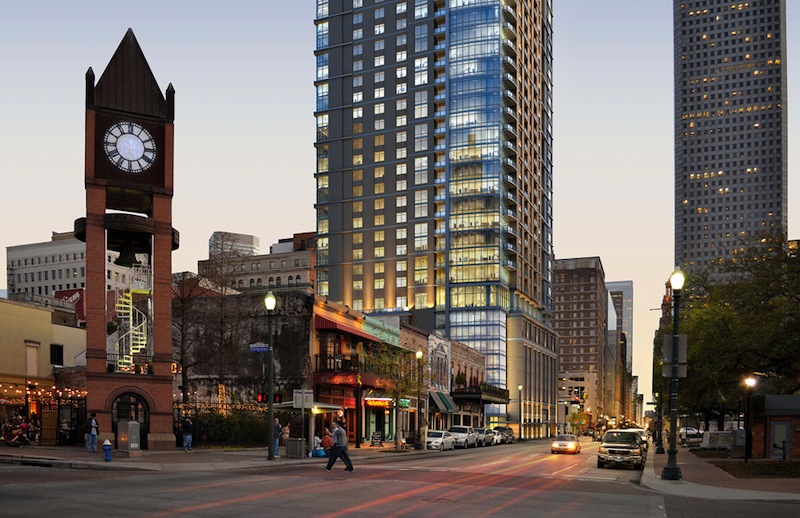 Situated in Houston’s historic Hines Market Square district is a 32-story luxury tower that will be home to 274 residents. Most of the multifamily that’s being built in the U.S. is rental, and much of it is in or near urban centers where both young and older renters and empty nesters are gravitating. Photo: courtesy Ziegler Cooper
Situated in Houston’s historic Hines Market Square district is a 32-story luxury tower that will be home to 274 residents. Most of the multifamily that’s being built in the U.S. is rental, and much of it is in or near urban centers where both young and older renters and empty nesters are gravitating. Photo: courtesy Ziegler Cooper
“If someone tells you that the desirability of urban life is waning, don’t believe them,” adds Arden Hearing, Managing Director of Trumark Homes’ Trumark Urban division, which has seven condominium projects in the works in San Francisco.
For many Americans, renting remains the only affordable way to get anywhere close to the urban core. “We’re offering them access to locations they couldn’t get otherwise,” says AvalonBay’s Birenbaum. Even on the urban fringe or in the suburbs, renters want the buzz of an urban center, says Tom Wermers, CEO of San Diego-based developer/contractor Wermers Companies.
Wermers sees more developers leaning toward walkable, transit-oriented projects. Wendy Dunnam-Tita, AIA, LEED AP, a Principal with architecture/engineering firm Page’s Austin office, seconds that notion. “Public transportation is changing the way people are buying land for projects in Austin,” she says. “More of our clients are emphasizing a sense of community that will make their projects more desirable.”
It’s a similar story in Houston, which Scott Ziegler, AIA, Principal with local design firm Ziegler Cooper, says is experiencing something of an urban renaissance. (Sperry Van Ness reports that half of Houston’s 11,000 multifamily deliveries in 2014 were in urban submarkets.) Ziegler Cooper’s recent work in that metro includes seven apartment towers, including the 28-story, 361-unit Catalyst in Houston’s central business district, which broke ground last summer, and will feature high- and low-rise apartments (the latter forming a streetscape). Ditto for Dallas, where the firm designed the 507-unit Preston Hollow Village, a 42-acre complex that offers three apartment types—850 sf for Millennials, 1,150 sf for young professionals, and 1,600 sf for empty nesters.
Much of this activity is being fueled by renters who crave what Ziegler calls “the 20-minute bubble,” where everything they want or need is close by and doesn’t require going onto a highway.
Trend #2: Seeking affordability, while worshipping at luxury’s altar
Many renters may aspire to live in or close to downtown, but that lifestyle doesn’t come cheap. A significant percentage of prospective renters are in a financially fragile state, and their housing options are narrowing as more and more developers and investors slavishly pursue deep-pocket customers.
“Most high-rises being built today are luxury,” says Robert Hidey, President, Robert Hidey Architects, Irvine, Calif., which has worked with most of the big multifamily builders in California. Gilbane’s Cava calls the luxury segment “definitely one of our focal points.” To attract these customers, he says, high-end properties must offer such amenities as infinity pools and upgraded design features in common areas, such as $25-30/sf flooring.
Bruce Percelay, Chair of The Mount Vernon Company, a Boston-based developer and property manager, acknowledges that “there’s a ton” of luxury apartments being built, but he would like to see more rental that’s directed at the middle class. “Right now, we’re in a crisis because construction and land prices [militate against] building for the middle class,” he says.
If land, labor, and material costs won’t cooperate, some are trying to tackle affordability from other angles, such as controlling operating costs.
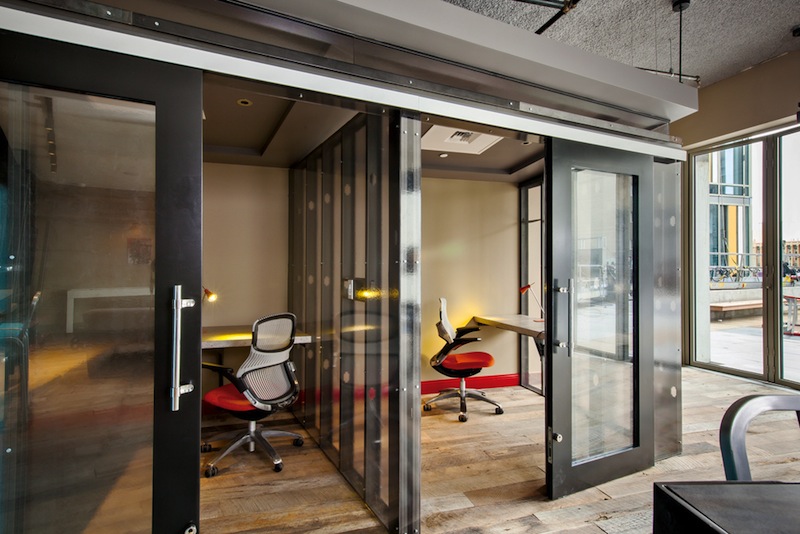 AvalonBay’s 273-unit, 16-floor high-rise, AVA at 55 Ninth in San Francisco, includes enclosed workstations in common areas for residents who require a bit of solitude for their labors. Business centers are now everywhere in modern apartment buildings, which also feature reliable WiFi as part of their live/work offering. Photo: courtesy AvalonBay Communities
AvalonBay’s 273-unit, 16-floor high-rise, AVA at 55 Ninth in San Francisco, includes enclosed workstations in common areas for residents who require a bit of solitude for their labors. Business centers are now everywhere in modern apartment buildings, which also feature reliable WiFi as part of their live/work offering. Photo: courtesy AvalonBay Communities
That’s what one of Page’s clients, the real estate investment and management company Presidium Group, asked for on its first ground-up project in Austin. On Presidium’s behalf, Page brought in San Francisco-based Atelier Ten to do energy modeling for a planned 300-unit apartment building. Based on that analysis, Page designed a number of energy-savings systems into the final project: a variable refrigerant flow HVAC system, a central solar hot water system, LED lighting, rainwater collection, and turbines powered by wind and natural gas.
In markets where rental affordability is particularly acute, developers are simply building smaller units. Wermers says that, five years ago, his company’s apartments averaged about 1,000 sf; today, they’re 8-10% smaller. One way Page is making smaller apartments more attractive and efficient, says Peter Hoffman, its Senior Design Architect, is by creating multifunctional spaces within the apartment unit.
The ne plus ultra of downsizing is the “micro” apartment.
In Houston, Ziegler Cooper has designed micros as small as 250-350 sf that are renting for $910 per month, versus $1,200 to $1,400 for a 565- to 600-sf junior one-bedroom. Ziegler thinks the micro concept works because Millennials don’t spend a lot of time in their apartments. “It’s the equivalent of a pied à terre,” he says.
Location is the leading factor influencing people’s decision to move into small units, according to a new Urban Land Institute report, “The Macro View of Micro Units” (www.BDCnetwork.com/ULImicrounits), based on an analysis of 400 apartment communities in 35 metros and responses from 3,500 renters. The study found that access to a grocery store ranks as the top priority among people who said they were considering a switch to micro units.
“The trend toward smaller units is an attempt to address the affordability issue,” adds Sandy Silverman, AIA, Principal, Practice Leader for Mixed Use and Multifamily Residential with Perkins Eastman. In Washington, D.C., the firm has designed a mixed-use building as part of the massive project called The Wharf, along the District’s Southwest waterfront. Micros will comprise 171 of the 500 apartments in the building.
But not everyone is sold on micros. Percelay of Mount Vernon says he has trouble figuring out where the actual savings accrue for the Building Team. Marcus & Millichap’s Seebee says he’s “a little surprised” at how receptive certain markets have been to micros—they’ve been given the go-ahead in New York City, San Francisco, and Boston––but doubts they’ll catch on nationally because “some communities are concerned about who will be living in these apartments 20 years from now” and whether micros will continue to command the rents they’re getting today.
Trend #3: Battling it out in the amenities arms race
As apartments are shrinking, common areas are expanding and are being designed to meet the needs of tenants who want to gather socially or do work there. “Residents, in particular Millennials, use these spaces for socializing with other residents and guests, or as ad hoc living space,” says Silverman
Common areas are being equipped with the technology needed to facilitate these live-work interactions. USB ports, dependable WiFi, iCafes, and other Web-access features are now common practice. To withstand greater usage, common areas are being decked out with more durable furniture and carpeting.
THE LATEST AMENITIES
Bike storage and repair
Car-sharing service
Child-care service
Concierge
Cooking classes
Dry cleaning/laundry service
Free WiFi
iCafe
Package delivery management
Personal shopper
Pet grooming
Rock-climbing wall
Rooftop terrace
Spa/massage center
Tech/business center
Wine cellar
Yoga/Aerobics/Wellness classes
Common spaces—especially in luxury buildings—are starting to resemble hotels and resorts in their look and feel, and in the services they provide. An apartment building that Balfour Beatty built in Charlotte, N.C., offers tenants cooking classes conducted by chef educators from Johnson and Wales University, which is conveniently located across the street.
Concierges who cater to tenants’ every whim are on call at some multifamily communities. The quality of a property’s amenities plays a huge role in the clientele it attracts and the rents it can fetch. “The common complaint about amenities is that they’re like your grandmother’s living room: they’re nice to look at, but nobody ever uses them,” quips Picerne’s Massie. “We prefer to install amenities that people actually use.”
But tenant demand for more and better amenities has launched an arms race among property owners. Dry cleaning services, lofts with office space, and private elevators are only some of the more esoteric amenities finding their way into multifamily dwellings.
Rooftop decks and terraces are now must-haves for mid- and high-rise buildings, says Wermers. The trappings of these terraces include comfy seating, sonic sound systems, big-screen TVs, kitchens with barbecue grilles and pizza ovens, and even cabanas.
One amenity that’s undergone significant transformation in recent years is the fitness center. No longer just a place to exercise, the fitness center has become the place where tenants gather and socialize. Classes for yoga, aerobics, cardio and strength training, and wellness in general are very much in vogue. While some apartment building owners have chosen to sidestep the issue by simply offering tenants passes or discounts to nearby gyms, others have gone nuclear with their on-site fitness centers. A Wermers Companies project has a 12,000-sf gym with a rock-climbing wall.
Multifamily housing is also in the throes of what Ziegler calls “a bike and dog revolution.” With parking spaces at a premium, building owners are providing bicycle stations for parking, storage, and even parts and repairs. Avalon Princeton, in New Jersey, will have its own bike “spa,” where bikes can be parked, stored, and repaired—a first for AvalonBay. In Philadelphia, the 15-story Museum Towers II development incorporates a freestanding storage area for 90 bikes.
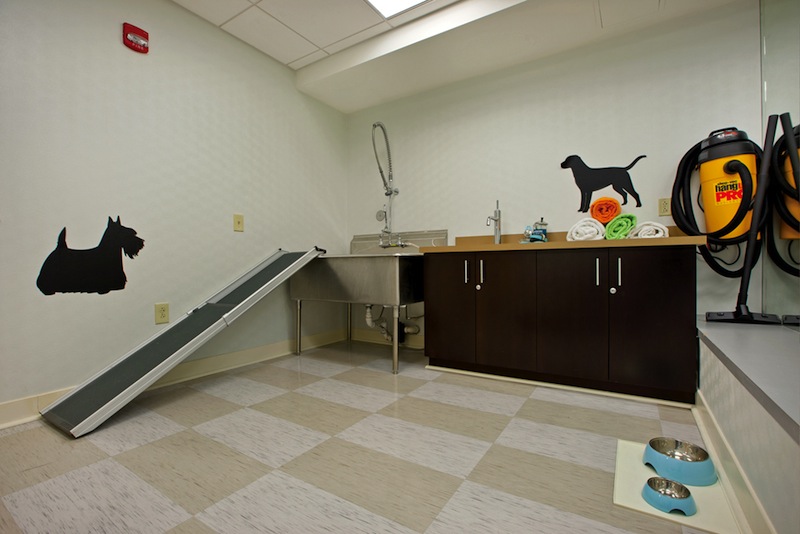 The quality and number of amenities that a multifamily building offers can often determine its rentability. Some newer amenities that these properties are finding they can’t do without are bike rack stations and “pet spas,” where residents can groom and exercise their furry friends. Photo: courtesy The Wermers Companies
The quality and number of amenities that a multifamily building offers can often determine its rentability. Some newer amenities that these properties are finding they can’t do without are bike rack stations and “pet spas,” where residents can groom and exercise their furry friends. Photo: courtesy The Wermers Companies
Bike-friendly amenities present new spatial and security problems for architects and contractors: where do you put them, and how do you keep them safe? There can even be regulatory concerns. A recent zoning change in bike-centric Washington, D.C., now requires one bike space for every three new residential units built. “That’s quite high compared to the national average,” says Silverman.
Pet-friendly buildings are also becoming de rigueur. Pet owners can account for anywhere from 20 to 90% of a building’s residents. At minimum, they expect their residential communities to offer animal grooming services and exclusive recreational areas for pets. Wermers Companies’ recently renovated Clayton on the Park, an apartment building in St. Louis, adding a pet salon. In San Diego, Alliance Residential has an agreement with a pet care shop called Hairy and Merry Pet Spa & Dog Wash, which offers a host of grooming, stay, and play services.
Trend #4: Giving tenants more control over technology
“The holy grail is to customize and personalize services,” says Brad Cribbins, COO for Phoenix-based Alliance Residential, one of the country’s largest property management companies. He estimates that Alliance tenants pay $850 to $900 a year in amenities fees, but he’d love to see that figure go up to $1,200, $1,500, even $2,000. He concedes that this would not be easy, since most tenants view amenities as entitlements.
Cribbins was a panelist at the National Multifamily Housing Council’s OpTech Conference & Exposition in November. Other discussions at that event reflected an ongoing debate about the efficacy of technology as an amenity and a tool to help tenants and property managers lower their respective operational costs.
Because technology can change so rapidly, Building Teams and building owners are struggling with how to deal with the next wave of innovations. For example, while a growing number of tenants might want Internet TV access, few property owners are ready to cut their buildings’ cords from cable or satellite delivery.
The industry is slowly moving toward giving tenants greater command over their environments—from entry doors to HVAC systems. The giant builder/developer Forest City has installed cloud-connected devices in apartment projects in Dallas and Washington, D.C. These devices allow tenants to monitor and regulate their lighting, heating, and cooling, says Mike Smith, Forest City’s VP of Technology Service.
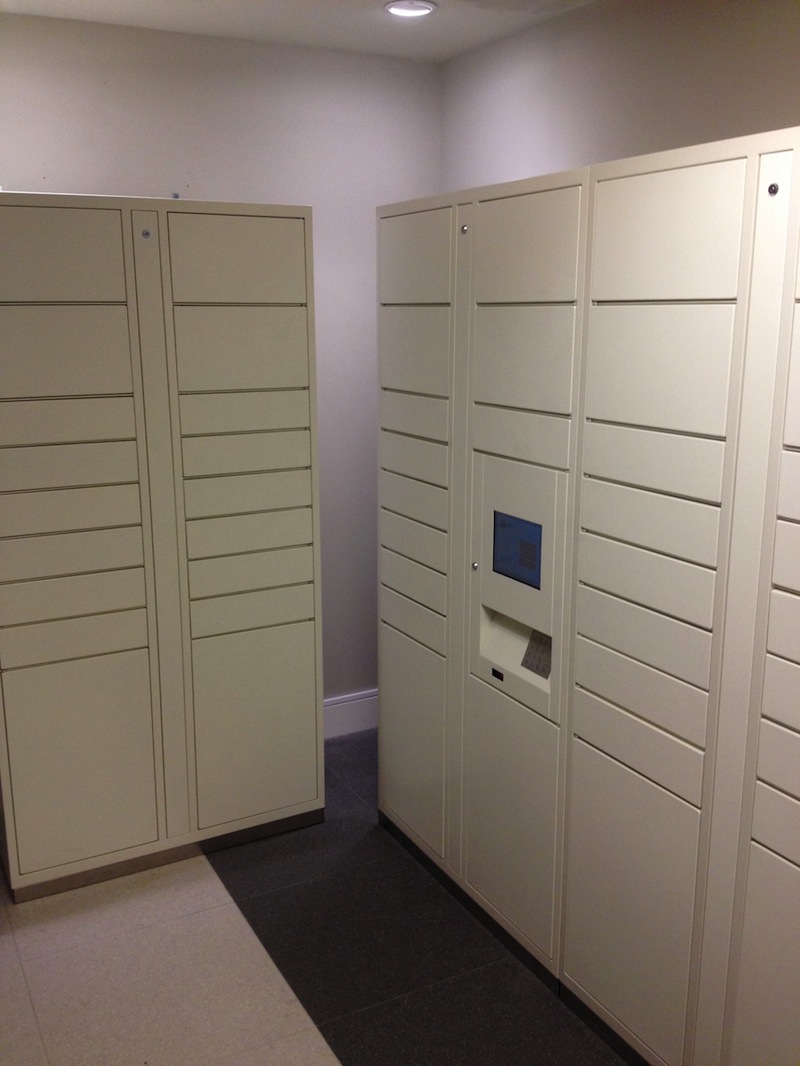 Property managers are handling the avalanche of packages they’re being asked to accept by turning to lockers that send out emails to tenants when their parcels are delivered. Photo: courtesy Parcel Pending
Property managers are handling the avalanche of packages they’re being asked to accept by turning to lockers that send out emails to tenants when their parcels are delivered. Photo: courtesy Parcel Pending
One area where building owners and their Building Teams are definitely receptive is technology that enhances a building’s sustainability, especially when it comes to attracting green-conscious Millennials. “Sustainability is becoming an industry standard,” says Colin Schless, LEED AP BD+C, CPHC, Senior Project Director for Thornton Tomasetti. One of the engineering firm’s recent projects is an affordable 50-unit apartment building in Portland, Maine, that is being built to Passive House standards, with a very basic HVAC system and 12-inch-thick walls.
Technology might also provide an answer to a problem that is vexing many property managers: how to handle the avalanche of packages cascading into their buildings. Camden Property Trust, which owns and operates 171 buildings with 60,314 units, handled about 750,000 packages in 2014, 50% more than in 2013, says Kristy Simonette, Camden’s SVP of Strategic Services. Most apartment buildings don’t have the storage space or manpower to handle this load.
Owners and property managers are investigating options that include installing on-premises package lockers. Amazon.com offers such a service, but only for Amazon deliveries.
Last June, Parcel Pending, an Irvine, Calif.-based startup, installed its first smart lockers in a test with Shea Properties. When a package is delivered, it is placed in a locker; the tenant is sent a text message and email with a unique six-digit access code to open the locker. Lori Torres, Parcel Pending’s CEO, says her lockers are “courier agnostic.” She calculates that a 300-unit apartment building would need about 50 lockers. The property manager would decide how long to hold a package, and how much, if anything, the tenant would be charged for the service.
Trend #5: Having tenants sign a green lease
In October, the last of three new buildings opened in the eight-building Green District in Boston’s Allston neighborhood. The district’s 500 apartments, ranging from 600 to 1,150 sf, have been leasing from $1,800 to $3,200 a month, or 30-50% below other developments in the surrounding area, placing them among Boston’s most affordable living options.
They’re also among the most energy-efficient apartment complexes in the area. Two of the new wood-framed buildings are certified LEED for Homes Platinum, one Gold. The Edge, one of the LEED Platinums, is a four-story building with 79 loft-style apartments. It has a white-painted, highly reflective roof with solar panels, floor-to-ceiling windows, electric-car charging stations, on-premise Zipcars, and bike storage. Its envelope was designed with a thermal barrier, high-performance glazing, soy-based insulation, and an energy-efficient mechanical system with high-performance monitoring and controls.
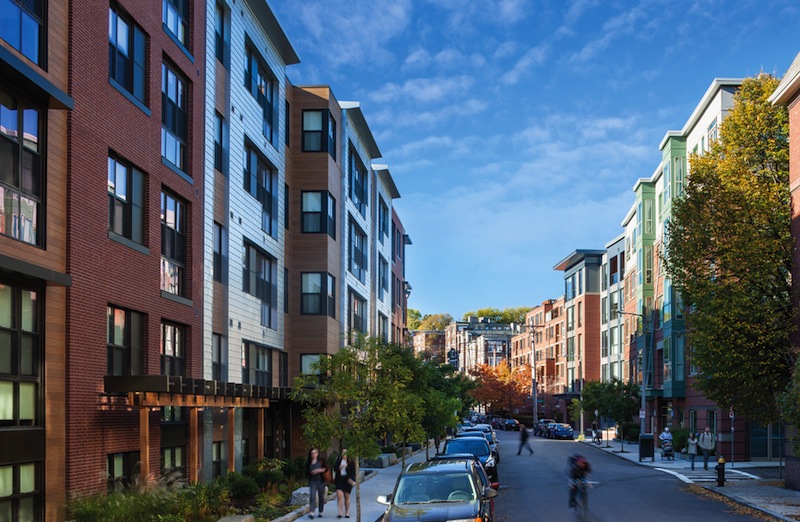 Tenants living in one of the eight buildings in The Green District, in Allston, Mass., are required to sign “green” leases, in which they agree to sustainable practices such as composting and using nearby public transportation. The developer, The Mount Vernon Company, attributes the accelerated leasing these buildings have enjoyed to sustainable marketing. Photo: Warren Jagger
Tenants living in one of the eight buildings in The Green District, in Allston, Mass., are required to sign “green” leases, in which they agree to sustainable practices such as composting and using nearby public transportation. The developer, The Mount Vernon Company, attributes the accelerated leasing these buildings have enjoyed to sustainable marketing. Photo: Warren Jagger
None of that would mean much if residents weren’t equally committed to sustainable living. “If you have a high-performance building but a low-performance tenant, what’s the point?” asks David Chilinski, AIA, Co-founder and President of Prellwitz Chilinski Associates, the project architect.
So tenants are required to sign a “green lease,” which the city of Boston created in order for this project to get its green-district designation. By signing that lease, tenants agree to follow sustainable lifestyle routines, such as recycling, composting, and using nearby public transportation.
Bruce Perceley, Chair of The Mount Vernon Company, the project’s developer, says the buildings’ common areas include in-wall hydration stations that dispense purified water. Each tenant is issued a water bottle to use at those stations to reduce the need to dispose of plastic bottles.
This is one of the few multifamily residential buildings in the Boston market that meters each apartment’s water intake. Perceley claims that has helped reduce water consumption by 40%. Each unit also has its own HVAC system, which gives tenants more control over their energy use.
Chilinski says his firm was “very particular” about the building materials it chose. Plastic flooring made from recycled materials “will last forever,” he says. The zinc cladding materials were also specified for their longevity.
Every new unit was preleased before it was completed, says Perceley. He’s convinced that building green makes “a big difference” in attracting tenants. “It also changes tenants’ perception of the landlord” in a positive way, he says.
Perceley doesn’t think “green” translates into premium rents so much as it accelerates the leasing process. But he doesn’t have to pitch his clients on green anymore. “They’re in the game,” he says. “They aren’t looking to me for leadership.”
Mount Vernon has agreed to sell the three new buildings to National Development for $150 million, but will continue to manage the properties.
WATCH OUT FOR SPEED BUMPS IN MULTIFAMILY HOUSING DEMAND
Preferences for multifamily living remain strong, but will they last? While Lend Lease’s Jeff Arfsten, COO and Managing Director of Project Management and Construction-Americas, anticipates an eventual swing back to homeownership––assuming rents keep escalating and banks and the federal government ease restrictions on mortgage lending––that shift could take a while, if current trends are any indication.
The National Association of Realtors estimates that first-time buyers accounted for only 33% of total homebuyers in 2014, a 27-year low. It’s probably no coincidence that the increase in single-person households has corresponded with the ongoing reduction in homeownership as a percentage of total households, which fell to 64.3% in the third quarter of 2014, according to the Commerce Department. Meanwhile, the rental apartment vacancy rate that quarter stood at 7.4%, the lowest it’s been since Q1/1995.
While multifamily construction has been increasing at a much faster clip than single-family construction, the New York Times, quoting Census Bureau and Haver Analytics estimates, reported recently that multifamily starts in 2014 were only about equal to where they were in 2004.
Still, there is concern in some quarters that multifamily demand might be approaching its apex. NAHB forecasts that multifamily starts will increase by only 3.8% in 2015 and 2% in 2016. Last September, Yahoo Finance and Multifamily Quarterly openly speculated about whether multifamily construction might be overheating. (Both concluded that it was not, at least not yet.
Then there’s the matter of rising costs. “We think it’s going to be tough [to build] in primary markets because land is tapped out,” says The Picerne Group’s Massie, which is already looking at secondary markets for growth.
Nevertheless, industry sources continue to point to economic, demographic, and cultural factors that they believe will energize multifamily demand for several years. Marcus and Millichap’s Seebee notes that total housing starts still lag total household formations by about 200,000 annually.
Axiometrics predicts that most metros should be able to handle more multifamily deliveries. And everyone is keeping an eye on interest rates and employment to see which might tip the rent-versus-own balance.
Lend Lease’s Arfsten points to Chicago—which, along with Miami, was Ground Zero for the condo collapse during the last recession—as a paradigm of the multifamily sector’s revival. Chicago created nearly 80,000 new jobs and delivered 4,500 rental apartments last year. An $80 million project called 4 East Elm, with 35 residences, is the first high-rise condo building to be marketed on Chicago’s North Side since 2007, according to the Chicago Tribune. Several other condo projects in the city’s West Loop tech hub and South Loop also moved into their marketing phases last fall.
“We’re fortunate that multifamily is a key market sector for us, and that it’s come back in a strong way,” says Arfsten.
Related Stories
Adaptive Reuse | Mar 26, 2024
Adaptive Reuse Scorecard released to help developers assess project viability
Lamar Johnson Collaborative announced the debut of the firm’s Adaptive Reuse Scorecard, a proprietary methodology to quickly analyze the viability of converting buildings to other uses.
Green | Mar 25, 2024
Zero-carbon multifamily development designed for transactive energy
Living EmPower House, which is set to be the first zero-carbon, replicable, and equitable multifamily development designed for transactive energy, recently was awarded a $9 million Next EPIC Grant Construction Loan from the State of California.
Adaptive Reuse | Mar 21, 2024
Massachusetts launches program to spur office-to-residential conversions statewide
Massachusetts Gov. Maura Healey recently launched a program to help cities across the state identify underused office buildings that are best suited for residential conversions.
Multifamily Housing | Mar 19, 2024
Jim Chapman Construction Group completes its second college town BTR community
JCCG's 200-unit Cottages at Lexington, in Athens, Ga., is fully leased.
Multifamily Housing | Mar 19, 2024
Two senior housing properties renovated with 608 replacement windows
Renovation of the two properties, with 200 apartments for seniors, was financed through a special public/private arrangement.
MFPRO+ New Projects | Mar 18, 2024
Luxury apartments in New York restore and renovate a century-old residential building
COOKFOX Architects has completed a luxury apartment building at 378 West End Avenue in New York City. The project restored and renovated the original residence built in 1915, while extending a new structure east on West 78th Street.
Multifamily Housing | Mar 18, 2024
YWCA building in Boston’s Back Bay converted into 210 affordable rental apartments
Renovation of YWCA at 140 Clarendon Street will serve 111 previously unhoused families and individuals.
Adaptive Reuse | Mar 15, 2024
San Francisco voters approve tax break for office-to-residential conversions
San Francisco voters recently approved a ballot measure to offer tax breaks to developers who convert commercial buildings to residential use. The tax break applies to conversions of up to 5 million sf of commercial space through 2030.
Apartments | Mar 13, 2024
A landscaped canyon runs through this luxury apartment development in Denver
Set to open in April, One River North is a 16-story, 187-unit luxury apartment building with private, open-air terraces located in Denver’s RiNo arts district. Biophilic design plays a central role throughout the building, allowing residents to connect with nature and providing a distinctive living experience.


